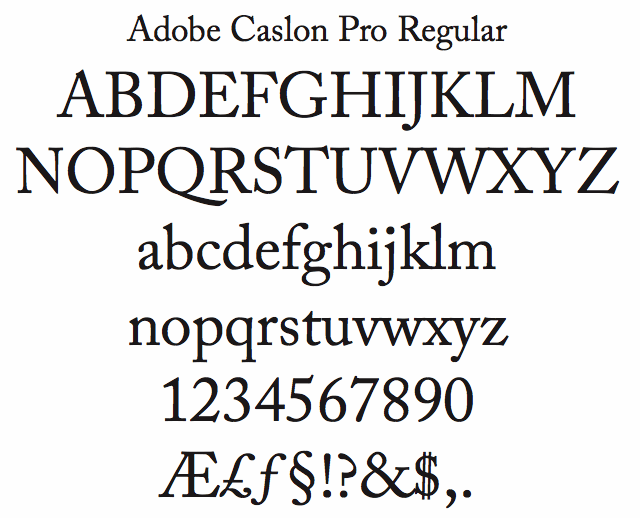
- Adobe caslon pro bold font works with full#
- Adobe caslon pro bold font works with pro#
- Adobe caslon pro bold font works with free#
These three combinations are all sans serif bold display faces with text typefaces. I feel a lot of dynamism in this pair of typefaces. It’s many eccentricities somehow fall into a beautiful harmony on the page. Jenson, modeled after the earliest humanistic typefaces of the fifteenth century, is a standard in book typography. I find the little flared hints at serifs on Poppl-Laudatio really bring out the fun and lively side of Minion, and they make me smile when I see them together.Ĭlick to enlargeSome people don’t like Lithos, but used with care it has great character and dense color. Minion is an oldstyle typeface with a distinctive “color” on the page.
Adobe caslon pro bold font works with pro#
Myriad Pro is a complete type family with a lovely modern verve, and the two together just seem to fit. Caslon is a smooth, easy reading text face rooted in the typefaces of William Caslon, an eighteenth-century printer in Britain. If you don’t know what typefaces to use in your book, try these, I think you’ll like them.Ĭlick to enlargeTwo great typefaces (and with a tip of the hat to Carla King!) that just produce beautiful music together. Here are three combinations of typefaces I particularly like. This gives a page in latin a much more orderly and linear look than the same typography in english. Latin has many fewer letters with ascenders and descenders-the parts of the letters that rise above, or fall below, the main line of text. For instance, a page with a more than average number of “…ing” verbs will have a different “color” than other pages because of the number of lower-case gs.Ĭlick to enlargeSometimes latin is used to “greek” text (That’s odd, isn’t it? We use latin to greek text.), but the look you get is deceptive. The english language has quirks to it, like any language, and sometimes those quirks create typographic patterns. 3 Great Combinationsīook designers, in my experience, tend to have a very limited palette of favorite typefaces they go back to again and again. In most nonfiction books, we use a combination of display and text typefaces, and the interaction between the two designs, when they are complimentary, is like a harmony of voices.
Adobe caslon pro bold font works with full#
But if you enlarge the letters, you can see right away that they are full of idiosyncrasies and flourishes.ĭisplay typefaces, on the other hand, announce themselves to the reader in no uncertain terms. They can be so quiet you just don’t notice them. For something more modern, check out the CANGGU monoline script, that’s perfect for blogs, social media, and the Web.The typefaces we use for books are a real contradiction. The Libre Caslon Text found on Google Fonts on the other hand, is optimized for the Web and would look awesome on all your digital designs.ĭo you love old, handwriting styles? Then you will love the TEMPLAR signature script, that looks as if it was indeed, written by hand.
Adobe caslon pro bold font works with free#
For the free versions, go to Fonts Geek for the Adobe Caslon Pro Regular and to Font Squirrel for Libre Caslon. Get all the Adobe Caslon fonts from Adobe Fonts. Don’t be afraid to complement it with similar serifs, too, such as Schnyder and Elmhurst. Of course, as a serif, it goes well with sans serifs like Akzidenz Grotesk, Interstate, and Graphik. From plays, posters, magazines, logos, even official documents and corporate letterheads – Caslon has, and always will, have a place in our time.īreathe new life to it by pairing it with unique typefaces such as NY Irvin and Schnyder. Nowadays, lots of designers still employ this Old Style serif in their works. Whether it’s for your digital portfolio or a book cover, you can’t go wrong with using Caslon. And why not? With its beautiful curves and rich history, there’s no other serif that’s as dependable. There’s a popular saying among type setters: ‘when in doubt, use Caslon’. The result is organic letters that bear close resemblance to the beloved serif of kings. Twombly designed them by studying specimen pages printed by William Caslon between 17. In 1990, type designer Carol Twombly created a Caslon revival called Adobe Caslon, which was more suited to digital needs.

Soon, they also became famous outside of England, making their way to the New World, just in time for the signing of the Declaration of Independence. The Caslon fonts were used extensively by people from all ranks, particularly in political arenas. His works gained fame because of their attractiveness and functionality. A notable English punchcutter, he designed many typefaces during this time, until his death in 1766. History of the Caslon FontĬaslon in essence refers to Old Style serifs originally created by William Caslon in 1722.


Read on to find out why it deserves a place in your toolkit.

That’s right – this Old Style serif has definitely earned its bragging rights thanks to its gorgeous forms and easily identifiable characters.


 0 kommentar(er)
0 kommentar(er)
